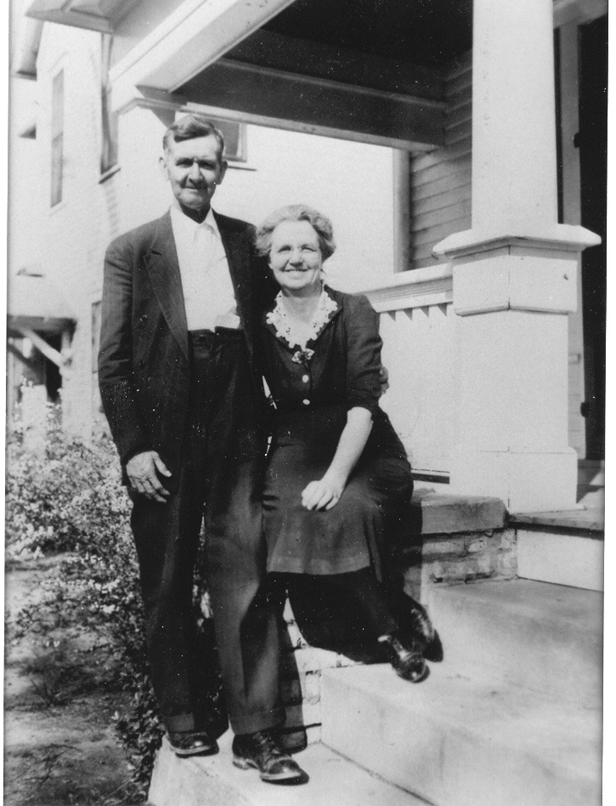|
Originally published in The East Ender newspaper, October 2004.
When it comes to the history of
East End, few know more or remember as much as Robert Haynes. The Haynes family name in East End dates back to about 1865
when his grandfather, Joseph Marion Haynes, moved to East End. His grandfather was an orphan at age 5 and was brought to East
End to work for and live with Will McCright.
In 1876, he married Martha Lou Young of East End and the
Haynes family roots in East End began. Haynes’ father, William Marion Haynes, and mother, Annie Lou Hale, had nine children
including Peggy, Ophelia, Mildred, Gene, Erma, Edwin, Claude, and Liburn. With that many children and many other cousins,
the Haynes name spread quickly in the area.
Haynes says the oldest settlers in the area were the Hicks,
Coles and Youngs. “Just about everyone has roots that go back to one of them,” said Haynes.
Haynes
knows a lot about the families in East End through his work with the Salem Cemetery that sits along Arch Street next to Harvest
Foods. The land originally belonged to Hiram B. Cole in the early 1800s. In 1840, two of the Cole children were buried on
the property. Later, two acres of land were given to the community to be used as a burial site.
In
1869, the Cole family gave the land to the Salem Methodist Church and they used the land until 1940 when the church transferred
the title of the property to the first cemetery committee. Haynes’ father was on that seven-member committee and was
given the responsibility to take care of the cemetery.
In the mid-1960s, Haynes was asked to serve
on the cemetery committee. He has taken a very active role in preserving the area. In a walk around the cemetery, he can tell
you something about almost everyone who has been laid to rest there.
“The original deed says
it’s a free burial ground for the community,” said Haynes, “but a person must have roots in East End to
be buried there.” Donations are gladly accepted. East Union Missionary Baptist Church and East End Baptist Church donate
money each month for the upkeep of the grounds.
Haynes says the churches have always been a big part
of the community. The first church was the Salem Methodist Church that was moved to Springlake Road, just north of East End
Road. That church eventually faded out according to Haynes. But down the street, East Union Missionary Baptist was growing.
Originally, East Union was located on Arch Street along the Pulaski/Saline County line by Lorance Creek. Haynes
says he remembers his mother talking about how easily that area would get flooded. “Momma talked about the water being
so deep that the mules (the form of transportation at the time) had to swim,” said Haynes.
About
1900, East Union moved the church building to its present location on Springlake Road. The land was donated by Jim Hale. “That
was my granddaddy on my mother’s side,” said Haynes.
In 1934, Jack Hogue held a three-week long tent
revival, near the present day elementary school. From that revival sprouted another church, East End Baptist. “It was
during the depression and people had to walk or come in a wagon to church,” said Haynes. He says it was too far for
many people in the community to travel to East Union, so they started another church closer to them after the revival. “It
was a distance thing. It was all peaceful,” said Haynes.
The next church was Trinity Pentecostal
Church that sits along Springlake Road south of Woodson Lateral. “A good fellow by the name of Luther Bradford started
that church in the late 1940s,” said Haynes. Later, Lorance Drive Church of Christ, Springlake Church of the Nazarene,
and East End Assembly of God, among others joined the area.
Haynes says he has seen East End grow a
great deal and says East End’s acceptance to the Sheridan School District in 1948 had a lot to do with it. “We
have to give a lot of credit (to Sheridan Schools) for East End growing like it has,” said Haynes. “People wanted
to get out of Little Rock and wanted a good school.”
East End got its name from the name of the school.
“In 1930, they built ‘East End School.’ They named it East End because it was in the east end of the county.
It was made up of four other small schools that consolidated,” said Haynes. Those other schools included East Union
School, which sat across the street from East Union Church, Duck Creek School, located on South Springlake Road, Loan Star
School, situated near the Pulaski/Saline County line, and Blount School, along Chicot Road.
About four
years later, Haynes says Fairview School, near Fairview Missionary Baptist Church, consolidated to East End as well.
The area was often referred to as Craig’s Mill before that. Haynes says there are birth certificates with
“Craig’s Mill” written on it to designate this area.
Haynes remembers the first phone
in the area around 1933. Haynes says that anyone who had to use a phone went to the house of Nick Hunter, who lived at the
intersection of Springlake Road and Lorance Drive.
Hunter had East End’s connection to the rest
of the world more than 70 years ago. But Robert Haynes carries today in his memory a connection to the community’s past.
(Editor’s note: Some information for this article was gathered from the History and Transcription of Salem
Cemetery by Charlotte Curlee Ramsey.)
 |
 |

|
| William Marion Haynes, and mother, Annie Lou Hale, married and had nine children. |
 |